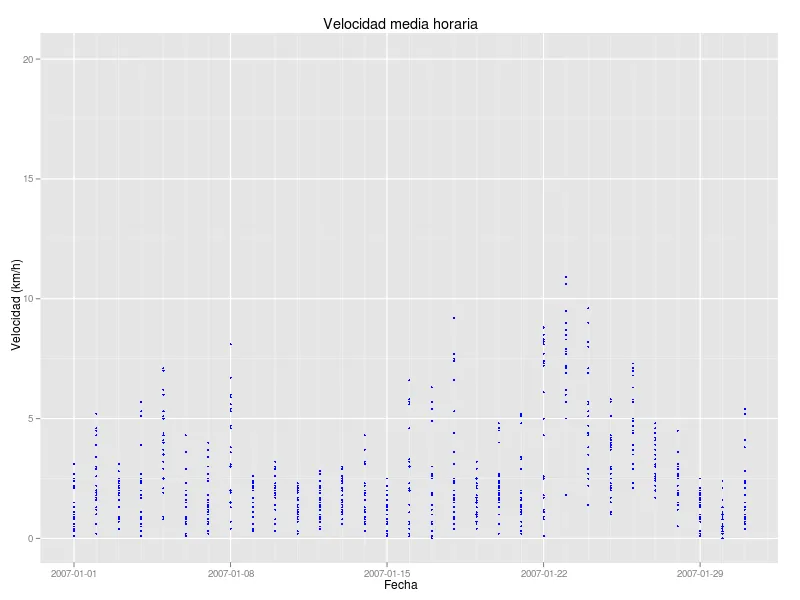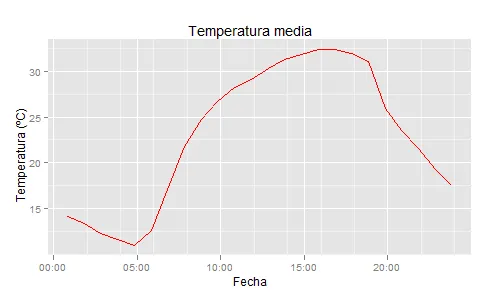我正在尝试使用ggplot2绘制来自气象站的每小时气象数据(这是我第一次使用ggplot)。我已经成功地绘制了日数据,但在将其降至小时级别时遇到了一些问题。数据文件看起来像这样:
FECHA H_SOLAR;DIR_M;VEL_M;TEMP_M;HR;PRECIP
01/06/14 00:50:00;314.3;1.9;14.1;68.0;-99.9
01/06/14 01:50:00;322.0;1.6;13.3;68.9;-99.9
01/06/14 02:50:00;303.5;2.1;12.3;70.9;-99.9
01/06/14 03:50:00;302.4;1.6;11.6;73.1;-99.9
01/06/14 04:50:00;306.5;1.2;10.9;76.4;-99.9
01/06/14 05:50:00;317.1;0.8;12.6;71.5;-99.9
01/06/14 06:50:00;341.8;0.0;17.1;58.8;-99.9
01/06/14 07:50:00;264.6;1.2;21.8;44.9;-99.9
01/06/14 08:50:00;253.8;2.9;24.7;32.2;-99.9
01/06/14 09:50:00;254.6;3.7;26.7;27.7;-99.9
01/06/14 10:50:00;250.7;4.3;28.3;24.9;-99.9
01/06/14 11:50:00;248.5;5.3;29.1;22.6;-99.9
01/06/14 12:50:00;242.8;4.7;30.3;20.4;-99.9
01/06/14 13:50:00;260.7;4.9;31.3;17.4;-99.9
01/06/14 14:50:00;251.8;5.1;31.9;17.1;-99.9
01/06/14 15:50:00;258.1;4.6;32.4;15.3;-99.9
01/06/14 16:50:00;254.3;5.7;32.4;14.0;-99.9
01/06/14 17:50:00;252.5;4.6;32.0;14.1;-99.9
01/06/14 18:50:00;257.4;3.8;31.1;14.9;-99.9
01/06/14 19:50:00;135.8;4.2;26.0;41.2;-99.9
01/06/14 20:50:00;126.0;1.7;23.5;48.7;-99.9
01/06/14 21:50:00;302.8;0.7;21.6;53.9;-99.9
01/06/14 22:50:00;294.2;1.1;19.3;67.4;-99.9
01/06/14 23:50:00;308.5;1.0;17.5;72.4;-99.9
我使用了以下R命令绘制数据:
datos=read.csv("utiel.dat",sep=";",header=T,na.strings="-99.9")
dia=as.Date(datos[,1],"%y/%m/%d") # Crear índice dia
veloc=zoo(datos[,c("VEL_M")],dia)
gveloc=ggplot(data=datos,aes(dia,veloc))
gveloc + geom_point(colour="blue",cex=1) + ylab("Velocidad (km/h)") + xlab("Fecha") + opts(title="Velocidad media horaria") + scale_x_date(limits = as.Date(c("2007-01-01","2007-01-31")),format = "%Y-%m-%d")
我得到了这个月度图表,其中包含来自同一天的所有数据,x坐标相同(即与预期相同的那一天)

我该如何读取日期和时间,以便每个点都可以在自己的x/时间坐标中绘制?我认为问题在绘图之前开始,但我找不到如何将日期读取为YY/MM/DD H:M:S
提前感谢
解决方案:只需添加以下代码即可使代码正常运行
datos$dia=as.POSIXct(datos[,1], format="%y/%m/%d %H:%M:%S") # Read date/time as POSIXct
ggplot(data=datos,aes(x=dia, y=TEMP_M)) +
geom_point(colour="red") +
ylab("Temperatura (ºC)") +
xlab("Fecha") +
opts(title="Temperatura media") +
scale_x_datetime(limits=c(as.POSIXct('2008/02/01'), as.POSIXct('2008/02/02')) ,format = "%Y-%m-%d")
希望这能对其他人有所帮助,感谢 Andrie 和 G.Grothendieck。
